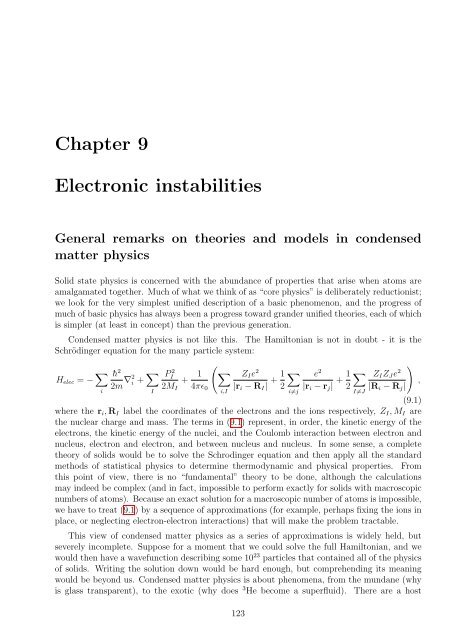Set of supplementary notes.
Set of supplementary notes.
Set of supplementary notes.
Create successful ePaper yourself
Turn your PDF publications into a flip-book with our unique Google optimized e-Paper software.
Chapter 9<br />
Electronic instabilities<br />
General remarks on theories and models in condensed<br />
matter physics<br />
Solid state physics is concerned with the abundance <strong>of</strong> properties that arise when atoms are<br />
amalgamated together. Much <strong>of</strong> what we think <strong>of</strong> as “core physics” is deliberately reductionist;<br />
we look for the very simplest unified description <strong>of</strong> a basic phenomenon, and the progress <strong>of</strong><br />
much <strong>of</strong> basic physics has always been a progress toward grander unified theories, each <strong>of</strong> which<br />
is simpler (at least in concept) than the previous generation.<br />
Condensed matter physics is not like this. The Hamiltonian is not in doubt - it is the<br />
Schrödinger equation for the many particle system:<br />
H elec = − ∑ h¯ 2<br />
2m ∇2 i + ∑ ( )<br />
PI<br />
2 + 1 ∑ Z I e 2<br />
2M<br />
i<br />
I 4πɛ 0 |r i − R I | + 1 ∑ e 2<br />
2 |r i − r j | + 1 ∑ Z I Z J e 2<br />
,<br />
2 |R i − R j |<br />
I<br />
i,I<br />
i≠j<br />
I≠J<br />
(9.1)<br />
where the r i , R I label the coordinates <strong>of</strong> the electrons and the ions respectively, Z I , M I are<br />
the nuclear charge and mass. The terms in (9.1) represent, in order, the kinetic energy <strong>of</strong> the<br />
electrons, the kinetic energy <strong>of</strong> the nuclei, and the Coulomb interaction between electron and<br />
nucleus, electron and electron, and between nucleus and nucleus. In some sense, a complete<br />
theory <strong>of</strong> solids would be to solve the Schrodinger equation and then apply all the standard<br />
methods <strong>of</strong> statistical physics to determine thermodynamic and physical properties. From<br />
this point <strong>of</strong> view, there is no “fundamental” theory to be done, although the calculations<br />
may indeed be complex (and in fact, impossible to perform exactly for solids with macroscopic<br />
numbers <strong>of</strong> atoms). Because an exact solution for a macroscopic number <strong>of</strong> atoms is impossible,<br />
we have to treat (9.1) by a sequence <strong>of</strong> approximations (for example, perhaps fixing the ions in<br />
place, or neglecting electron-electron interactions) that will make the problem tractable.<br />
This view <strong>of</strong> condensed matter physics as a series <strong>of</strong> approximations is widely held, but<br />
severely incomplete. Suppose for a moment that we could solve the full Hamiltonian, and we<br />
would then have a wavefunction describing some 10 23 particles that contained all <strong>of</strong> the physics<br />
<strong>of</strong> solids. Writing the solution down would be hard enough, but comprehending its meaning<br />
would be beyond us. Condensed matter physics is about phenomena, from the mundane (why<br />
is glass transparent), to the exotic (why does 3 He become a superfluid). There are a host<br />
123








